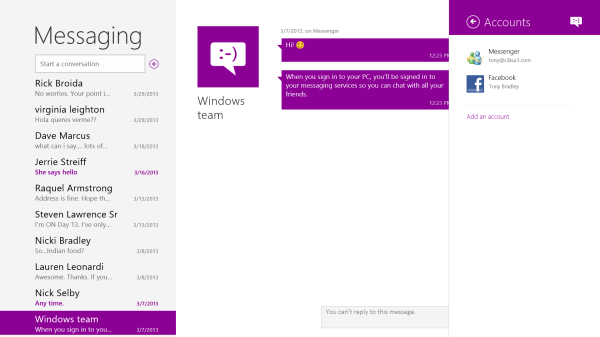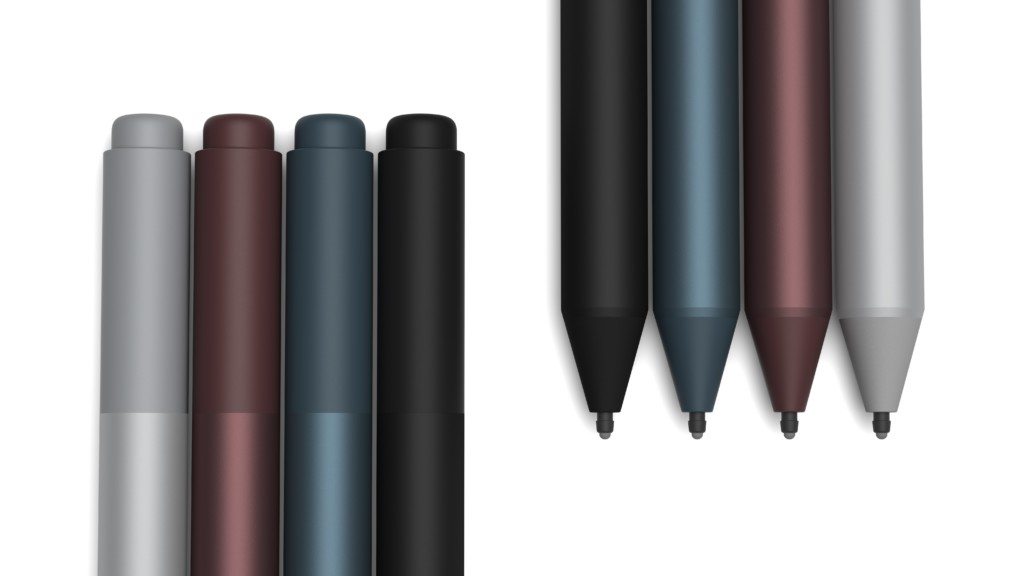30 Days with Surface Pro: Day 25
As I travel about using the Surface Pro on the go, I still need to keep in touch with people–clients, editors, family, and friends. For Day 25 of the 30 Days with Surface Pro series, I am taking a closer look at the Windows 8 Messaging app on the Surface Pro.
Instant messaging has always suffered from one major problem–platform lock-in. Whether I chose to use AOL Instant Messenger (AIM), ICQ, or some other service, it’s utility and value were determined by whether or not any of my friends, family, or co-workers (or how many of them) also participated on that same network. The desire / need to communicate with various parties meant installing multiple IM clients, and then trying to remember and keep track of which people to communicate with from which platform. The chaos and complexity sort of gets in the way of the whole point of communicating efficiently.
Now, instant messaging clients typically connect to and communicate with multiple instant messaging platforms. Depending on the app, I can use a single client to connect to AIM, Facebook, Yahoo, Google, Skype, Windows Messenger, ICQ, and more.
So, that brings me to the Messaging app in Windows 8 on the Surface Pro. It’s lacking. Severely.
The biggest problem is how limited it is. TK Keanini, CTO of nCircle (recently acquired by Tripwire), is a recent Surface Pro convert, and he and I chatted about the problems with trying to chat using the Messaging app. Keanini says, “The Messaging Modern UI client is nice to use but unfortunately it looks like it only supports MSN and Facebook. It is clear that it is more of a communication (in this case IM) for People [another Windows 8 default app] than anything else. I like the approach but I hate that it does not support the other IM services.”
Essentially, Messaging is just a conduit to Facebook messaging for me. Microsoft has a confusing array of services out there (Windows Messenger, Skype, Lync) that all seem to do the same thing, and I don’t personally know anyone who uses MSN or Windows Messenger or whatever it’s being called now. The only messages I receive on that service are phishing attacks from allegedly hot chicks looking to hook up. I’d rather not have the service turned on at all, but it’s a requirement of logging in using a Microsoft account.
The third-party app options are limited, but I found IM+. IM+ works with all of the services mentioned above, as well as a variety of more obscure instant messaging platforms I’ve never even heard of. It provides presence information in the Contacts pane–showing me which contacts are currently online, and which ones are not, or might currently be busy. IM+ can remain running in the background so others can contact me while I’m using other apps.
There is a problem with IM+, though, as well. In its defense, the issue is not unique to IM+. The problem is the “echo effect”. A Facebook messaging session will alert me through IM+, but it will also alert me through Facebook if I have the site open in my browser. Every incoming and outgoing message ends up popping up in two or more locations depending on how many different tools I have connected to Facebook messaging.
Just to clarify–I’m just using Facebook as an example here, the problem is not a Facebook problem. A new system needs to be developed that communicates across different platforms and clients to determine which one is the primary at that point in time and just work through that one rather than blasting all messages to all clients at the same time.
IM+ is a workable solution, but I have to choose between using a client with ads and limited features, or paying money to buy IM+ Pro. A better solution would be for Microsoft to just expand the capabilities of the Windows 8 Messaging app so that it can truly function as a hub of instant messaging communications.
Day 24: BYOD (Bring Your Own Device)
Day 26: Gaming on the Surface Pro
- Ransomware-Proof Your Data Backups with Immutability - April 10, 2024
- Unearthing Identity Threat Exposures - April 1, 2024
- Future of Tech and Cybersecurity Looks Bright Thanks to AI - March 26, 2024




Comments are closed.